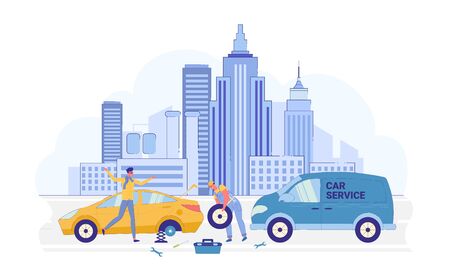1. Introduction to Autonomous Vehicles and Ethics
Autonomous vehicles (AVs) are transforming the way we think about transportation. These self-driving cars use advanced sensors, artificial intelligence (AI), and machine learning to navigate roads without human intervention. While they offer benefits such as improved safety, reduced traffic congestion, and increased mobility for those unable to drive, they also introduce complex ethical dilemmas.
How Autonomous Vehicles Work
AVs rely on a combination of sensors, cameras, radar, and AI algorithms to interpret their surroundings and make driving decisions. These systems allow cars to detect obstacles, predict movements of other vehicles or pedestrians, and follow traffic rules. The goal is to create safer roads by reducing human error, which is a leading cause of accidents.
Ethical Challenges in Decision-Making
One of the biggest challenges with AVs is how they make decisions in critical situations. Unlike human drivers, who rely on instinct and experience, AVs must follow programmed logic to determine the best course of action. This raises ethical questions, especially in life-or-death scenarios.
Key Ethical Dilemmas
| Ethical Dilemma | Description |
|---|---|
| Passenger vs. Pedestrian Safety | Should the AV prioritize the safety of its passengers or pedestrians in an unavoidable collision? |
| Decision in Unavoidable Accidents | When an accident is inevitable, how does the AV decide which action causes the least harm? |
| Responsibility and Liability | If an AV causes an accident, who is legally responsible—the manufacturer, the software developer, or the owner? |
Real-World Implications
The way these ethical issues are handled will impact public trust in AV technology. If the decision-making process is not transparent or fair, people may hesitate to adopt autonomous vehicles. Governments, automakers, and AI developers must work together to create ethical frameworks that ensure AVs make morally acceptable decisions while maintaining safety and reliability.
2. The Trolley Problem and Its Relevance
One of the most well-known ethical dilemmas used to discuss decision-making in critical situations is the trolley problem. Originally introduced as a thought experiment, this scenario challenges us to consider the moral implications of choosing between different outcomes when every option involves harm.
Understanding the Trolley Problem
The trolley problem presents a situation where a runaway trolley is headed toward five people on the tracks. You have the ability to pull a lever to switch the trolley onto another track, where it will only hit one person instead. The core question is whether it is morally acceptable to actively intervene and reduce harm by sacrificing one person to save five.
Applying the Trolley Problem to Autonomous Vehicles
Autonomous vehicles must be programmed to make split-second decisions in critical situations. These decisions often resemble the trolley problem, where a vehicle may have to choose between two harmful outcomes. Should the car prioritize pedestrian safety, the passengers inside, or a balanced approach? Engineers and ethicists must determine the guiding principles for these decisions.
Key Ethical Considerations
| Consideration | Explanation |
|---|---|
| Utilitarian Approach | Decisions should minimize overall harm, favoring actions that save the most lives. |
| Duty-Based Ethics | There may be a moral obligation to protect vehicle occupants first, mirroring manufacturer responsibility. |
| Public Perception | How society views morality in autonomous cars can shape acceptance and trust in the technology. |
Challenges in Implementation
One of the biggest challenges in applying ethical principles to autonomous vehicles is the lack of universal moral consensus. Different cultures have different beliefs on decision-making during emergencies. This adds complexity to designing universally accepted programming for autonomous vehicles.

3. The Ethics of Autonomous Vehicles: Decision-Making in Critical Situations
3. Decision-Making Algorithms and Moral Considerations
Autonomous vehicles (AVs) rely on complex decision-making algorithms to navigate traffic and respond to critical situations. These algorithms must process vast amounts of data and make split-second decisions that could impact human lives. But how do these systems determine the best course of action when faced with potential accidents? The answer lies in a combination of artificial intelligence, ethical principles, and real-world safety considerations.
How Autonomous Vehicles Make Split-Second Decisions
When an AV encounters a sudden obstacle, such as a pedestrian stepping onto the road or a vehicle braking unexpectedly, its sensors and AI-powered decision-making system assess multiple factors in milliseconds. These factors may include:
| Factor | Role in Decision-Making |
|---|---|
| Speed and Distance | Calculates how much time is available to react. |
| Surrounding Objects | Identifies other vehicles, pedestrians, and barriers. |
| Road Conditions | Analyzes factors like wet pavement or potholes that could impact maneuverability. |
| Passenger Safety | Assesses the risk to vehicle occupants. |
| Legal and Ethical Guidelines | Determines if an action complies with traffic laws and moral frameworks. |
By processing all these elements rapidly, the AV selects an action that minimizes potential harm and optimizes safety for all involved.
Moral Frameworks Guiding AV Decisions
Ethical dilemmas arise when an AV must choose between two unfavorable outcomes. For example, if avoiding a collision with another car means swerving into a pedestrian, how should the vehicle decide? Ethical frameworks that guide these decisions include:
Utilitarian Approach
This framework focuses on minimizing overall harm. The AV would choose the option that results in the least amount of injury or damage, even if it means prioritizing multiple lives over one.
Deontological Approach
A deontological perspective follows strict moral rules, such as never intentionally harming a pedestrian. Under this system, the vehicle may prioritize obeying laws and avoiding certain ethical violations, even if it leads to a suboptimal outcome in terms of casualty numbers.
Human-Centric Approach
Some argue that AVs should prioritize their passengers’ safety above all else, much like a human driver would instinctively protect themselves in a crisis.
Each of these frameworks has advantages and shortcomings, and researchers are still debating the best approach for programming AVs to handle ethical dilemmas effectively.
Programming Ethics into Autonomous Systems
Developing ethical AV algorithms is a collaborative effort between engineers, policymakers, and ethicists. Developers need to ensure that AVs adhere to traffic laws while also incorporating moral reasoning that aligns with societal values. Additionally, governments and regulatory bodies are working to establish legal standards that guide ethical decision-making in AVs.
As autonomous technology continues to evolve, balancing automation with human values remains an ongoing challenge. The decisions we make today in programming AVs will ultimately shape the ethical landscape of future transportation.
4. Legal and Policy Implications
Examining the Legal Responsibilities and Policy Challenges
As autonomous vehicles (AVs) become more advanced, their ability to make ethical decisions in critical situations raises important legal and policy concerns. Questions around liability, regulatory frameworks, and governmental oversight need to be addressed to ensure these vehicles operate safely and fairly.
Who Is Liable in an Autonomous Vehicle Accident?
One of the biggest legal challenges surrounding AVs is determining liability when an accident occurs. Traditionally, human drivers are responsible for accidents caused by errors or reckless behavior. However, with AVs making decisions on their own, legal responsibility becomes more complex.
| Scenario | Potential Liable Party |
|---|---|
| Software malfunction causes a crash | Manufacturer or software developer |
| Sensor failure leads to an incorrect decision | Hardware supplier or manufacturer |
| Human passenger overrides self-driving system | Human operator or vehicle owner |
| Government-approved algorithm makes an ethical decision leading to an accident | Government agency, manufacturer, or no clear party |
Regulatory Challenges for Autonomous Vehicles
Setting rules for AVs involves balancing innovation with public safety. Current traffic laws are designed for human drivers, making it difficult to adapt them for AI-driven decisions. Governments must determine regulations that address ethical decision-making without stifling technological progress.
Key Policy Questions
- Should AVs have standardized ethical decision-making rules across all states?
- Who should be responsible for auditing and approving AV algorithms?
- How should insurance policies adapt to accommodate AV-specific risks?
- What rights do passengers have in cases where the AV makes a controversial decision?
The Need for Global Cooperation
Because AV development is a global effort, international policy coordination is essential. Countries have different legal frameworks, and conflicting regulations could slow progress and create confusion. Collaborative efforts between governments and companies can help establish ethical and legal standards that work across borders.
5. Public Perception and Societal Impact
As autonomous vehicles (AVs) become more advanced, public perception plays a crucial role in their widespread adoption. Many people are excited about the future of self-driving cars, while others remain skeptical or even fearful. Understanding these perceptions helps us address concerns and increase confidence in AV technology.
How the Public Views Autonomous Vehicle Ethics
The ethical decisions made by AVs in critical situations significantly impact how the public perceives them. People want to know that these vehicles will make morally sound decisions when facing unavoidable accidents. However, opinions vary on what the “correct” ethical choice should be.
Factors Influencing Public Trust
Several factors shape public trust in AVs, including safety records, media reports, and personal experiences with automation. Below is a breakdown of key elements that influence how society perceives AV ethics:
| Factor | Impact on Public Trust |
|---|---|
| Safety Record | Positive safety data increases trust, while accidents or malfunctions reduce confidence. |
| Media Coverage | News reports can shape perceptions positively or negatively, depending on how AV incidents are portrayed. |
| Transparency from Companies | Clear communication about ethical decision-making increases public acceptance. |
| Regulatory Oversight | Government rules and safety standards reassure people that AVs follow ethical principles. |
Impact on Adoption Rates
The publics willingness to adopt AV technology depends on whether they trust it to make ethical and safe decisions. If people feel that AVs prioritize safety and fairness, they are more likely to support their widespread use. Conversely, ethical controversies or high-profile accidents can slow adoption rates.
Steps to Improve Public Confidence
- Education and Awareness: Providing clear information on how AV ethics work can ease public concerns.
- Real-World Testing: Allowing people to experience AVs firsthand helps build familiarity and trust.
- Stronger Regulations: Government regulations can ensure ethical decision-making standards are met.
- Transparent Communication: AV companies should openly address ethical dilemmas and how their systems handle them.
The Future of Public Trust in Autonomous Vehicles
As AV technology continues to evolve, public perception will play a significant role in shaping its future. By addressing ethical concerns transparently and ensuring safety, companies and regulators can work together to build trust and encourage broader adoption of autonomous vehicles.
6. Future Directions and Ethical Frameworks
As autonomous vehicles (AVs) continue to evolve, so do the ethical and regulatory challenges associated with their decision-making processes. Addressing these concerns requires a combination of technological innovation, legal frameworks, and ethical guidelines that can guide AVs in critical situations.
Potential Solutions for Ethical Decision-Making
One of the key challenges for AVs is determining how they should react in unavoidable accidents. Several approaches are being explored to tackle this ethical dilemma, including:
| Solution | Description |
|---|---|
| Rule-Based Ethics | Pre-programming AVs with a fixed set of ethical rules to follow in emergencies. |
| Machine Learning Ethics | Using AI to improve decision-making based on real-world accident data and human ethical preferences. |
| Publicly Voted Models | Allowing the general public to vote on ethical scenarios, shaping AV decision algorithms. |
| Personalized Ethics | Giving vehicle owners the ability to set ethical preferences for their AV. |
Regulatory Developments
Governments and other regulatory bodies are working to establish clear guidelines for AV ethical decision-making. Key developments include:
- Federal Policies: In the U.S., agencies like the National Highway Traffic Safety Administration (NHTSA) are working on AV safety standards.
- State-Level Laws: Some states have introduced specific AV legislation, including liability rules and testing regulations.
- International Cooperation: Countries are collaborating to create universal AV standards to ensure consistent safety measures worldwide.
Evolving Ethical Frameworks
Different ethical theories are being considered to guide AV decision-making. Some of the most debated frameworks include:
Utilitarian Approach
This approach prioritizes the greatest good for the greatest number. In an emergency, an AV following a utilitarian model would choose actions that minimize overall harm, even if it means sacrificing the few to save the many.
Deontological Ethics
Deontological ethics focus on following strict moral rules, regardless of the consequences. Under this model, an AV might always prioritize pedestrian safety over passenger safety or vice versa, adhering to predefined ethical principles.
Value-Based Decision-Making
Some researchers suggest AVs should adapt their decision-making based on human values gathered through public input and cultural considerations, creating a flexible but ethically consistent system.
Looking Ahead
The ethics of AV decision-making remain a complex and evolving challenge. While technology continues to improve, policymakers, engineers, and the public must collaborate to create ethical and regulatory frameworks that ensure safe and fair decision-making in critical situations.


